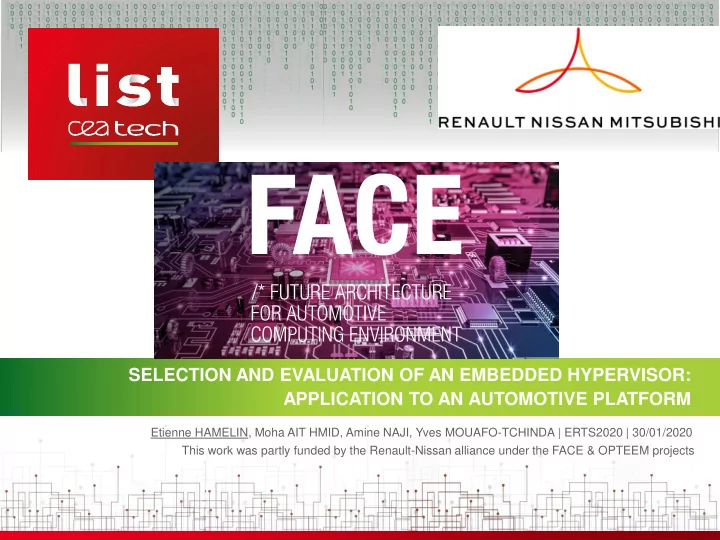

SELECTION AND EVALUATION OF AN EMBEDDED HYPERVISOR: APPLICATION TO AN AUTOMOTIVE PLATFORM Etienne HAMELIN, Moha AIT HMID, Amine NAJI, Yves MOUAFO-TCHINDA | ERTS2020 | 30/01/2020 This work was partly funded by the Renault-Nissan alliance under the FACE & OPTEEM projects
SUMMARY Context & motivation for the automotive domain A rational selection process The multi-step filtering process Quantitative characterization Conclusions ERTS2020 | Hamelin Etienne | 30/01/2020 | 2
CONTEXT & MOTIVATION • More SW functions on fewer, high-perf SoCs • Centralized computing platform • Common motherboard • Modularity via general-purpose or specialized SoCs daughter boards • Mother- & daughterboards host heterogeneous SW payloads from various SW suppliers SW payload Computation Safety-relevant Security-relevant − + ~ Command & control ADAS + + ~ Multimedia, infotainment + − + ERTS2020 | Hamelin Etienne | 30/01/2020 | 3
CONTEXT & MOTIVATION • OK, so we need an embedded hypervisor… but which one? ERTS2020 | Hamelin Etienne | 30/01/2020 | 4
HOW TO CHOOSE? • So many criteria… evaluation effort non-technical Quantitative / nice-to-have Objective / Required / Technical/ subjective qualitaive Relative Hypervisor type (type I, type II, µK-based) 1 0 1 0 1 Supported CPU architectures (x86, ARM, …) 1 0 1 1 1 Supported OS (full-/para-virtualized), exposed task API 1 0 1 0 1 Memory, peripherals management scheme 1 0 1 0 2 Scheduling scheme, real-time 1 0 1 0,5 2 Performances & overheads 1 1 1 0,5 3 Supports to safety, security, lifecycle 1 0 1 0,5 2 Signs of industrial maturity: prototype or field success stories 0 0 0 1 1 Safety/security certification or qualification packages 0 1 1 1 2 0 0 0 1 3 Usability (incl. tools, user guidance, examples) Licensing, partnership, support, business model 0 0 0,5 1 2 Price scheme 0 1 1 1 2 ERTS2020 | Hamelin Etienne | 30/01/2020 | 5
A RATIONAL SELECTION PROCESS • Scientific selection process: optimal choice • For each criteria, define evaluation method, relative weight: 𝑥 𝑘 • For each hypervisor & criteria, evaluate 𝑑 𝑗,𝑘 Select best hypervisor: 𝑡 ∗ = arg max σ 𝑘 𝑥 • 𝑘 ⋅ 𝑑 𝑗,𝑘 Easy, right? • But • 𝑜 hypervisors, 𝑛 criteria ⇒ 𝑜 × 𝑛 evaluations! • weights tuning very subjective • Empirical approach: multi-step filtering • Assess criteria most easily evaluated, and most discriminative • Filter out solutions below threshold • Repeat until 1 solution ERTS2020 | Hamelin Etienne | 30/01/2020 | 6
APPLICATION IN THE AUTOMOTIVE DOMAIN SELECTION OVERVIEW ~ days of effort ~ weeks ~ months ERTS2020 | Hamelin Etienne | 30/01/2020 | 7
APPLICATION IN THE AUTOMOTIVE DOMAIN SELECTION OVERVIEW 23 solutions evaluated CPU arch., periph. support Real-time Industrial maturity Safety- / Security qualification 5 editors interviewed Tool support Partnership model Applicable regulation 1 solution characterized Performances overheads, predictability Overall usability ERTS2020 | Hamelin Etienne | 30/01/2020 | 8
APPLICATION IN THE AUTOMOTIVE DOMAIN CHARACTERIZATION • Characterization • Performance overheads • virtualized vs. bare-metal • Inter-VM interferences • disturbed vs. undisturbed • Quantitative metrics • Boot time overhead • Memory overhead • Context switch overhead • Scheduling and interferences • Environment • Renesas RCar-H3: heterogeneous ARMv8A SoC • 4 × ARM Cortex-A57 (32kB L1I, 48kB L1D cache) • 2MB shared L2 • 4 × Cortex-A53 (32kB L1I, 32kB L1D cache) • 512kB shared L2 • 2 × Cortex-R7 Dual lockstep (32kB L1I, 32kB L1D cache) ERTS2020 | Hamelin Etienne | 30/01/2020 | 9
CHARACTERIZATION: A FEW FIGURES • Boot time • From last U-Boot instruction to first VM instruction • Depends on VM size • Measured ~16ms + 31ms per GB • Context switch time • Ping-pong message between 2 VMs • Measured ~ 8µs to 17µs (warm/cold caches) • Memory overhead • Hypervisor footprint + VMM memory per VM • Measured from 8MB (hello world app) to 28MB (full Linux VM) • Computational overhead • MiBench basicmath compute-bound tasks • Measured ~4% ERTS2020 | Hamelin Etienne | 30/01/2020 | 10
CHARACTERIZATION MEMORY BANDWIDTH & INTERFERENCES Native VM1: Linux + HBench-OS mem benchmark Core partitioning 12 000 VM2: optional perturbation (Hbench-OS based) Core partitioning + perturb Time-partitioning, cache 10 000 Native configuration flushing Time-partitioning, cache memcpy bandwidth (MB/s) flushing + perturb 8 000 6 000 4 000 2 000 L1 cache L2 cache size size 0 2k 4k 8k 16k 32k 64k 128k 256k 512k 1m 2m 4m 8m block size ERTS2020 | Hamelin Etienne | 30/01/2020 | 11
CHARACTERIZATION SHARED SERVICES, E.G. NETWORK TCP bandwidth (MB/s) 35 30 25 20 15 10 5 0 Undisturbed Perturbated • Inter-VM shared services: virtual network • Hbench-OS TCP bandwidth benchmark, server/client configuration (bench) + server/client (disturbance) • From ~31MB/s (undisturbed) down to ~3MB/s: 90% bandwidth loss • 2 simultaneous sources of interference • Shared software service used by both pairs • Service handler (partition) can preempt user application ERTS2020 | Hamelin Etienne | 30/01/2020 | 12
FEEDBACK FOR THE AUTOMOTIVE DOMAIN • Feedback • Perf. overheads limited (boot time, CPU time, context switch, mem) • Impact of inter-VM interferences on predictability • shared HW (e.g. caches, TLB) • SW services (e.g. shared Eth.) • even in time-partitioning with L1 cache & TLB flush • Usage recommendation • Mitigate interference through hardware • Reduce resource sharing between real-time & best-effort worlds • Leverage L2 cache separation between clusters • Mitigate shared services-induced interference • Software monitoring / rate-control usage of shared services ERTS2020 | Hamelin Etienne | 30/01/2020 | 13
OVERALL CONCLUSION • Selecting a software platform is a strategic choice… • High technical stakes • compatibility, performance, features • many issues can often be dealt with usage restrictions or additional developments • Non-technical stakes sometimes even higher • partnership & licensing, • business-model, • regulation ERTS2020 | Hamelin Etienne | 30/01/2020 | 14
Recommend
More recommend